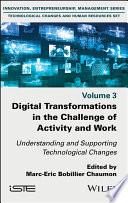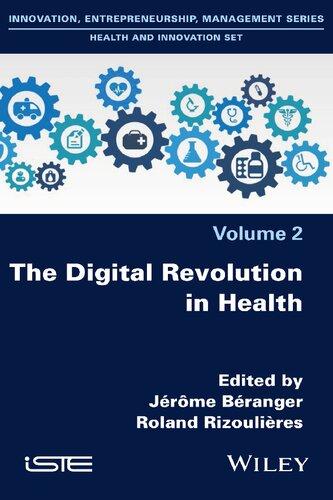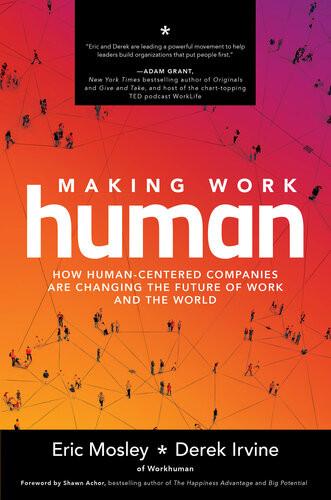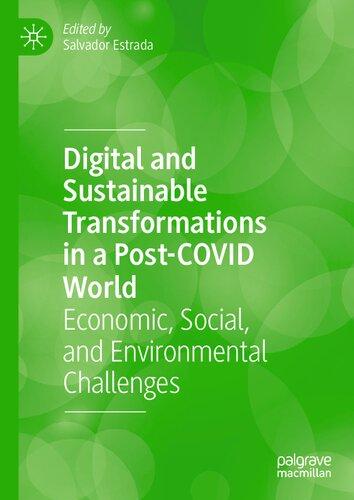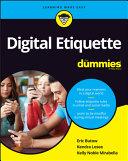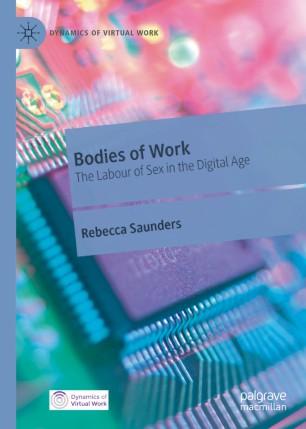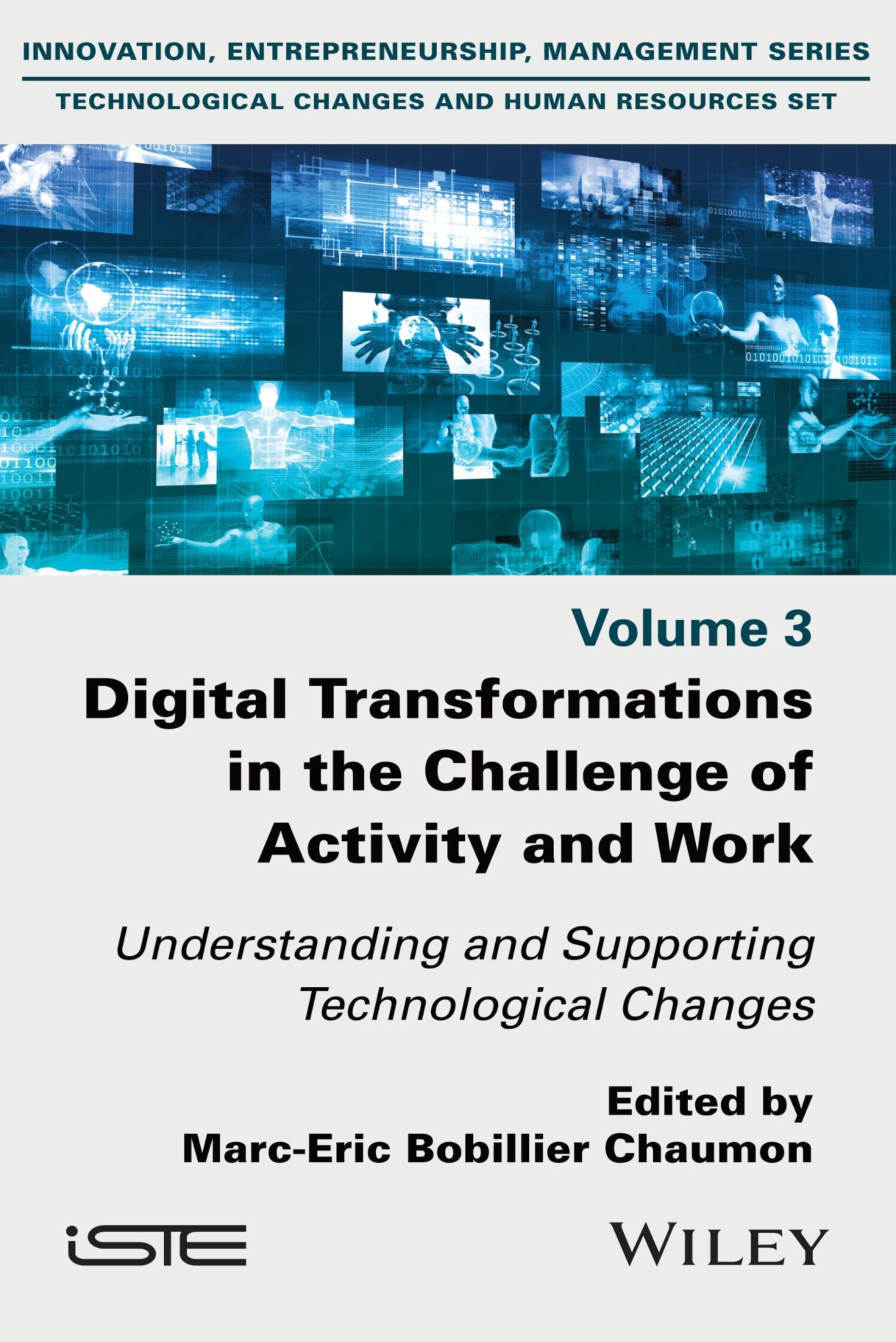Digital Transformations in the Challenge of Activity and Work: Understanding and Supporting Technological Changes Marc-Eric Bobillier Chaumon
Visit to download the full and correct content document: https://ebookmass.com/product/digital-transformations-in-the-challenge-of-activity-an d-work-understanding-and-supporting-technological-changes-marc-eric-bobillier-chau mon/
More products digital (pdf, epub, mobi) instant download maybe you interests ...
The Digital Revolution in Health: Challenges, Issues, and Transformations 1st Edition Jerome Beranger
https://ebookmass.com/product/the-digital-revolution-in-healthchallenges-issues-and-transformations-1st-edition-jeromeberanger/
Making Work Human Eric Mosley
https://ebookmass.com/product/making-work-human-eric-mosley/
Digital and Sustainable Transformations in a Post-COVID World: Economic, Social, and Environmental Challenges
Salvador Estrada
https://ebookmass.com/product/digital-and-sustainabletransformations-in-a-post-covid-world-economic-social-andenvironmental-challenges-salvador-estrada/
Digital Etiquette For Dummies Eric Butow
https://ebookmass.com/product/digital-etiquette-for-dummies-ericbutow/
Understanding the Work of Nurse Theorists 3rd Edition, (Ebook PDF)
https://ebookmass.com/product/understanding-the-work-of-nursetheorists-3rd-edition-ebook-pdf/
Bodies of Work: The Labour of Sex in the Digital Age 1st ed. Edition Rebecca Saunders
https://ebookmass.com/product/bodies-of-work-the-labour-of-sexin-the-digital-age-1st-ed-edition-rebecca-saunders/
Social Work and the Grand Challenge to Eliminate Racism: Concepts, Theory, and Evidence Based Approaches
Martell L. Teasley
https://ebookmass.com/product/social-work-and-the-grandchallenge-to-eliminate-racism-concepts-theory-and-evidence-basedapproaches-martell-l-teasley/
Strategies for Supporting Inclusion and Diversity in the Academy: Higher Education, Aspiration and Inequality 1st ed. Edition Gail Crimmins
https://ebookmass.com/product/strategies-for-supportinginclusion-and-diversity-in-the-academy-higher-educationaspiration-and-inequality-1st-ed-edition-gail-crimmins/
The Book of Crypto: The Complete Guide to Understanding Bitcoin, Cryptocurrencies and Digital Assets Henri Arslanian
https://ebookmass.com/product/the-book-of-crypto-the-completeguide-to-understanding-bitcoin-cryptocurrencies-and-digitalassets-henri-arslanian/
Digital Transformations in the Challenge of Activity and Work
Technological Changes and Human Resources Set coordinated by Patrick Gilbert
Edited by
Marc-Eric Bobillier Chaumon
First published 2021 in Great Britain and the United States by ISTE Ltd and John Wiley & Sons, Inc.
Apart from any fair dealing for the purposes of research or private study, or criticism or review, as permitted under the Copyright, Designs and Patents Act 1988, this publication may only be reproduced, stored or transmitted, in any form or by any means, with the prior permission in writing of the publishers, or in the case of reprographic reproduction in accordance with the terms and licenses issued by the CLA. Enquiries concerning reproduction outside these terms should be sent to the publishers at the undermentioned address:
ISTE Ltd
John Wiley & Sons, Inc.
27-37 St George’s Road 111 River Street London SW19 4EU Hoboken, NJ 07030
UK USA
www.iste.co.uk
www.wiley.com
© ISTE Ltd 2021
The rights of Marc-Eric Bobillier Chaumon to be identified as the author of this work have been asserted by him in accordance with the Copyright, Designs and Patents Act 1988.
Library of Congress Control Number: 2020946633
British Library Cataloguing-in-Publication Data
A CIP record for this book is available from the British Library
ISBN 978-1-78630-529-9
2.3. Stakes for the development of activity: knowing how to give meaning to a poly-contextual and multi-mediated activity
2.3.1. Networking, the power to act and meaning at work
2.3.2. Sharing a degree of collaborative intentionality in a multi-mediated situation, a skill in its own right............................
2.4.
2.5.
Camille SAGNIER, Émilie LOUP-ESCANDE and Gérard VALLÉRY
3.1.
3.2.
3.2.1.
3.2.3.
3.2.4.
3.3.
3.3.4.
4.1.
4.2.
4.2.2.
4.2.3.
4.3.
Chapter
Chapter 4. Robotization in Industries: A Focus on SMEs
Sandrine BERGER-DOUCE
4.3.1.
Chapter 5. Serious Games for Vocational Training:
Lydia MARTIN, Julian ALVAREZ and Antoine TALY
5.1.
5.2.
5.4.
5.4.1.
5.4.2.
5.4.3.
Chapter 6. The “Old” Issues of the “New” Artificial Intelligence
Tamari GAMKRELIDZE,
Moustafa ZOUINAR and Flore BARCELLINI
6.1.
6.2.
6.3.
6.4. The “new” generation of AI and the old challenges
6.4.1. From the substitutive approach of automation to the complementary approaches of human–machine systems
6.4.2. The challenges of “new” AI systems in work situations
6.5. What are the approaches to designing and integrating AI systems in work situations?
6.6.
6.7.
7.1.
7.2.
7.3.
7.4.
7.4.1.
Elodie CHAMBONNIÈRE and Jacqueline VACHERAND-REVEL
8.1.
8.2.
8.2.1.
8.2.2.
8.3.
8.4.
8.5. Confirming
8.5.1.
8.5.2.
8.5.3.
8.6.
8.6.1.
8.6.2.
8.6.3.
8.7.
8.8.
Chapter 9. Integrating Collaborative Robotics into Work Situations: The Intentions of SME Managers in the Digital Transformation of their Companies .........................
Anne-Cécile LAFEUILLADE, Flore BARCELLINI, Willy BUCHMANN and Tahar-Hakim BENCHEKROUN
9.1. Transformations in work situations seen through the prism of technocentric solutions
9.2. Models of leadership activity to understand change management processes ..
9.2.1. The activity of managers at the crossroads of different roles
9.2.2. Developing the intention of managers in change management processes: the contribution of the dialogical model of design
9.3. Methodology for data collection and analysis
9.4. Managers’ desires in the face of reality: an encounter that helped to shape their intentions
9.4.1. Elements shaping managers’ desires
9.4.2. The “conversation” between the desire and reality..............
9.5. The reality, a messenger from the past, in a
9.6.
Irène POIDI, Marc-Eric BOBILLIER CHAUMON and Jacqueline VACHERAND-REVEL
10.1.
Part 3.
Maria IANEVA, Raluca CIOBANU and Chiara LAI
11.1.
11.2. Transformation of spaces and transformation of work and employment: “spatialized work”
11.3. From “spatialized work” to the division between space and work
11.4. Flexible work environments: from work to “activity”
11.4.1. The example of the design of the workspaces of a large company: the reconfiguration of work areas
11.4.2. From space allocation to the redefinition of associated tasks .......
11.5. What theoretical models for considering space and its transformations?
11.6.
11.7.
Chapter 12. Digital Work, Disposable Work? When Opportunities to
The division of complex digital
12.3. Chronic indeterminacy of the
12.4. When the contingencies regime
Chapter 13. Is the Obsolescence of the Skills of Older Employees an Inevitable Consequence of Digitalization?
Florence CROS, Marc-Eric BOBILLIER CHAUMON and Bruno CUVILLIER
13.1.
13.2.3. From the effects of technology on activity to the issue of the obsolescence of older workers’ skills
13.3. Question and methodology
13.3.1.
13.3.2. Engeström’s activity system model (1987)
13.4. Main
13.4.1. The ASCT profession: a perception through the prism of age
13.4.2. Overcoming tensions to develop one’s activity
13.5. Discussion and conclusion.............................
13.5.1. Accelio, a vector of recognition for the ASCT profession?
13.5.2. Diverting to work
13.6.
Chapter 14. Are Work Collectives and Digital Exposure
Pauline CROUZAT and Marc-Eric BOBILLIER CHAUMON
14.1. Collective activity: major
14.2. Engineering: a highly
14.3. Problem
14.4. The methodology
14.5. Main results: virtually hyper-instrumented
14.6.
14.7.
Part 4. Approaches and Methods for Conducting
Chapter
Jean-Marc ROBERT, Antoine MARTIN, Mitra TARAGHI, Clément COLIN, Masood MALDAR, Flavie BONNEVIOT and Eric BRANGIER
15.1.
15.2.
15.3.
15.4.
15.5.
15.6.
15.6.1.
15.6.2.
15.7.
15.8.
Chapter
Laurent VAN BELLEGHEM
16.1.
16.4.1.
16.4.2.
Clotilde CORON and Patrick GILBERT
17.1.
17.2.
17.3.
17.3.1.
17.3.2.
17.4. A model for responsible leadership of technological change
Chapter 18. Exploring the Situated Acceptance of Emerging Technologies
and Concerning
Marc-Eric BOBILLIER CHAUMON
18.1.
18.2. Models
18.3.1. Evaluating the situated acceptance of technologies already in place to support the future technological transformation project
18.3.2. Exploring the acceptance of emerging technologies to co-construct the creation project in/by the activity
18.4.
Introduction
There has been an acceleration in technological change within the workplace. This is because innovations and the deployment of technical solutions are multiplying (AI, robotization, immersive environment, Big Data, collaborative platforms, factory of the future, etc.). At best, the implementation of these new devices provokes simple transfers of use and learning (which are iterative or incremental technologies), and, at worst, they provoke real disruptions in use (which are disruptive technologies) (Bobillier Chaumon 2016). These can require a profound rethinking of the user experience, which can cause employees to fail and make it more difficult for them to carry out their activity. Therefore, new organizational and socio-cognitive models are required, as the devices call for alternative ways of thinking, doing and collaborating at work.
Professional activity thus depends less and less on the direct intervention of individuals in terms of the object of work than on their actions within these digital work environments, that is, on technological artifacts that mediate this activity. This distancing phenomenon is consubstantial with the quality of the “human–machine” systems used: if a system is complex to use (i.e. designed with an insufficient level of usability) or if it is difficult to attribute meaning to this technical artifact to make it a truly useful and enabling instrument for one’s activity (notion of situated acceptance), the individual can be expected to experience difficulties in carrying out work in which he or she recognizes himself or herself and for which he or she is recognized. There is therefore a link between successful technologies and successful work, between a good quality technological environment and a good quality of work, and between the benefit of appropriate technical environments and the wellbeing of their users.
Introduction
written by Marc-Eric BOBILLIER CHAUMON.
New ways of working are also accompanying the deployment of these emerging technologies: dematerialization of work processes, design of dynamic work spaces, automation of intellectual tasks, and the renewal of human–machine collaboration modes with (high-level) tasks that are delegated to systems, distributed among several actors and broken down into multiple spaces/times (nomadism, home office, coworking). These new ways of acting also correspond to new ways of suffering, which are expressed by cognitive and psychic loads of a new order and by potential socio-professional and organizational constraints (obsolescence of skills, renewal of professions, etc.).
While technologies can therefore re-enhance work and re-qualify the individual, they can also contribute to distorting the activity and divesting the subject of everything that make sense to them: in their professional practices and ties as well as in their room for maneuver and relationship with work. The dematerialization of activity can therefore be to the detriment of the employee and their work. This is because ICTs are implemented to either replace the individual or appropriate that which represents the core of their activity: that which has meaning and makes sense. However, these tools imply reconfigurations and requirements that destabilize work and weaken the individuals and collectives in place. The question of introducing ICTs and their constant renewal in organizations therefore fundamentally refers to the place and role that these devices play in the activity and its implementation conditions (factors of occupational health and well-being), as well as the way in which human factor specialists (occupational psychologists, sociologists, ergonomists, etc.) can grasp them in their interventions.
Considered as both a current and prospective reflection attempting to grasp the logic and modalities of the digital transformations taking place, this book has several goals:
1) to take stock of the current situation and define precisely what these new technologies and new working methods are that are being deployed in companies;
2) to understand the role they can play in organizational effectiveness and human efficiency;
3) to discuss the role of these technologies in the development (or prevention) of activity and their potential impact on the conditions for exercising the activity, the sources of well-being and the quality of life at work (occupational health);
4) to reflect on the approaches and modalities of support for these digital transformations, based on an anthropocentric, participatory and inclusive approach.
A total of 18 contributions provide epistemological support (from a theoretical and methodological point of view) and empirical illustrations (from field surveys) for these lines of thought. They come from teacher-researchers and practitioners who have been conducting interventions on the deployment of technologies in work organizations and consider the analysis and support of these digital transformations.
These perspectives provide multidisciplinary and complementary insights – in the field of occupational psychology, ergonomic psychology, ergonomics, sociology of uses, management sciences, etc. – on how these technologies are transforming work systems and how they can be better managed.
Thus, conceived both as a work of analysis and reflection on the socio-technical changes affecting the world of work in the future and in the making, and also as a handbook for understanding the major technological innovations and the approaches to support digital transformations in progress, each chapter – grouped into four main parts – enriches our understanding of the dynamics at work.
1) The first part provides an overview of the digital transformations and the various emerging technologies that are spreading throughout organizations.
Chapter 1 by Marc-Eric Bobillier Chaumon provides an overview of the various emerging technologies that are gradually being seen in companies, and discusses their paradoxical uses and impacts on work. Bobillier Chaumon also discusses how he believes the human and social sciences should accompany the design and deployment of these technical innovations so that they support business and promote the well-being of employees. Chapter 2 by Nadia Barville-Deromas and Marc-Eric Bobillier Chaumon focuses on the topic of collaborative technologies, and more specifically on the corporate digital social networks that are being massively spread throughout organizations in order to make communication fluid and to optimize synergies between professions and services. The authors question the psychosocio-organizational stakes that such cooperative platforms can represent on collective activity and mobilized skills. Chapter 3 by Camille Sagnier, Émilie Loup-Escande and Gérard Valléry proposes a critical analysis of immersive technologies based on virtual and augmented reality. The authors illustrate not only the contributions but also the constraints that these devices impose on the activity and the users, especially in the industrial sector. Chapter 4 by Sandrine BergerDouce gives an account of the situation of small and medium enterprises (SMEs), as well as their strengths and weaknesses with regard to robotization. It also proposes the means of support for these organizations and their employees, who prove to be poorly prepared or not at all prepared. Chapter 5 by Lydia Martin, Julian Alvarez and Antoine Taly gives us feedback on the serious game technique for learning
professional behaviors, and shows how debriefing and work group devices can promote learning transfers in work situations. Finally, Chapter 6 by Tamari Gamkrelidze, Moustafa Zouinar and Flore Barcellini defines the scope of action and the possible development of artificial intelligence (AI). The authors question the place and role of AI in professional activities and in the modalities/conditions of interaction between these innovative devices and humans.
2) The following thematic part focuses on the new ways of working caused or accelerated by digital transformations, providing analysis and feedback from various research studies.
Thus, Chapter 7 by Emilie Vayre reports on the psychosocial and socioprofessional issues of telework deployment within work organizations, based on a summary of various research works and publications. The author also suggests steps that can be taken to mark out the process of deploying telework in work structures. Chapter 8 by Elodie Chambonnière and Jacqueline Vacherand-Revel is based on an ethnographic study in the building sector that deals with the reconfiguration of pre-existing management practices of various key players on the building site and occupational risk prevention activity, following the introduction of a business application. The authors demonstrate the advantage of an ethnographic approach that immerses itself in the heart of this activity in order to be able to understand the multiple determinants of the evolution of these newly digitized managerial practices.
Chapter 9 by Anne-Cécile Lafeuillade, Flore Barcellini, Willy Buchmann and Tahar-Hakim Benchekroun focuses on collaborative robotics (cobotics) and the way it is considered and determined by the organizational projects of managers of SMEs. The authors demonstrate the importance of starting from the reality of the activity to shape the “desires” of transformation, a reflection similar to that of Irène Poidi, Marc-Eric Bobillier Chaumon and Jacqueline Vacherand-Revel in Chapter 10 These authors show how technological artifacts are mobilized at different stages and for different functions in the process of creating innovative companies by young entrepreneurs. These technical devices then take on a status and a particular trajectory of use depending on the situations and activities in which they are employed. Finally, Chapter 11 by Maria Ianeva, Raluca Ciobanu and Chiara Lai on the new physical territories of digital activity proposes to question the outlines and challenges of space as an object of research and action in digital transformations. Their contribution seeks to qualify the psychosocial and organizational implications of these complex socio-technical devices (flexible spaces, unassigned positions), based on research carried out within the IT subsidiary of a large French group.
3) The third thematic part discusses more specifically the psychosocial, socio-organizational and occupational impacts of technology diffusion in work activity.
Chapter 12 by Maxime Besenval and Alexandra Bidet looks at the beginnings of engagement in digital, creative and collective work. Based on an ethnographic study of the sociology of work and uses in the video game design sector, the authors ask how far we can invest in and develop the opportunities offered by digital transformations – in terms of permanent and collective reconfiguration of the product of work – without threatening the possibility of workers engaging in it. Chapter 13 by Florence Cros, Marc-Eric Bobillier Chaumon and Bruno Cuvillier raises the issue of the obsolescence of the skills of older workers in the face of the challenges of technological change. This chapter illustrates that older people have major experiential and collective resources that enable them to cope with these transformations, and, above all, to regulate technical failures or work situations not covered by the new systems. Chapter 14, the last chapter of Part 3, by Pauline Crouzat and Marc-Eric Bobillier Chaumon sets out, on the one hand, to specify how the collective activity of an aeronautical engineering department can be reconfigured under the impetus of technology and, on the other hand, to examine the manifestations, resources and limits of these collective practices mediated by technology.
4) The fourth and final thematic part covers the methods and approaches that can be used to understand, design and support digital transformation projects.
Thus, Chapter 15 by Jean-Marc Robert, Antoine Martin, Mitra Taraghi, Clément Colin, Masood Maldar, Flavie Bonneviot and Eric Brangier aims to explain the place and role of the prospective ergonomics (PE) approach in the development of future products, services, processes and systems. The authors present two illustrations of innovative projects that apply the approach and methods of this perspective. Chapter 16 by Laurent Van Belleghem describes the interest of the activity simulation method in order to fully explain the new work configurations that these transformations foreshadow and to help design them. Two intervention experiments illustrate these ways of anticipating and co-designing probable future work. Chapter 17 by Clotilde Coron and Patrick Gilbert deals with the specificities of change management in the context of digital transformations, because they can be an amplifier, or even a catalyst, of social and professional inequalities. The authors present a model of change management that takes into account the specificities of technological change. Chapter 18, the last chapter by Marc-Eric Bobillier Chaumon, returns to the concepts and models of technological acceptability, which are crucial in the process of adopting and
deploying new technologies. The chapter also discusses their contributions and limitations. Based on the situated acceptance approach, he outlines the methods that, in his view, allow us to explore the acceptance of emerging technologies, based on the analysis of acceptable developments related to digitized activities.
Emerging Technologies and Issues for Activity and Occupational Health
The question of the introduction of emerging technologies and their constant renewal in organizations fundamentally refers to the place and role that these devices play in business, as well as how they can affect activity and health at work. Considered as a prospective reflection attempting to grasp the logic and modalities of the digital transformations underway, the ambition of this chapter is: (1) first, to identify and characterize the emerging technologies that are being deployed in the company; (2) to discuss their impact on the activity and well-being of employees, demonstrating the uses and paradoxical effects that these devices may have on work; and (3) finally, to reflect on the psychosocial function of these devices as potential operators of health and development of the profession.
1.1. Introduction
For several years now, we have been witnessing a major reconfiguration of the conditions in which work is carried out, in their nature (intensification, dematerialization, acceleration), in their modalities (remote working, nomadism, fragmentation, virtual teams) and in their reference points (fragmentation and dispersion of activity, multi-activity), due to the deployment of innovative technical solutions which are multiplying. The impact on the human factor is not neutral. The implementation of these emerging devices can, at best, provoke simple transfers of use and learning; they are iterative or incremental technologies. At worst, they can lead to real disruptions in use; they are then disruptive technologies (Bobillier Chaumon 2017). The latter require a profound rethinking of the user experience,
Chapter written by Marc-Eric BOBILLIER CHAUMON.
requiring new ways of doing, thinking, organizing and collaborating at work. New organizational and socio-cognitive models are then required to work with these devices (de Terssac and Bazet 2007; Ajzen et al. 2015), with strong implications for the health and well-being of employees (Bobillier et al. 2015). Anastassova (2006) and Loup-Escande and Burkhardt (2019) identify four specific characteristics of emerging technologies: (1) an innovative character, an important technological advance, partially achieved or in the making; (2) unclear and undifferentiated uses; (3) several limitations that slow down its massive application; and (4) a promise of transformation of the economic and social context in which it will be introduced.
The goal of this chapter is to question the place and impact that these emerging technologies can have in the often paradoxical transformations and development of activity. The first step will be to identify and characterize the emerging technologies that are being deployed in companies. Then, we will discuss the impact they may have on professionals and their activity.
1.2. From properties to the uses of emerging technologies
Disruptive digital innovation manifests itself through a variety of technologies that are being deployed in a number of business sectors. Thus, collaborative robots (cobots, exoskeletons), communicating, ambient or ubiquitous technologies (Internet of Things), artificial intelligence (voice assistants, decision support systems), evaluative and predictive data exploitation (Big Data), immersive environments (virtual and/or augmented reality) and new modalities of human–machine interaction (haptics, sensory, cognitive technologies of BIM (brain interface machine) type – brain interface machine) find applications in various fields of our professional and socio-domestic life. They can be found with the factory of the future, the hospital of the future, the smart home, autonomous transport, connected health (HCS/home care service, HS/home support; Martineau and Bobillier Chaumon 2017) or in the services offered by digital work platforms (uberization, robotics; Casilli 2019).
In order to understand the impact of technologies on professional activity and to identify research and societal issues that are addressed to the scientific community, it is necessary beforehand to clarify what they cover in terms of uses and practices, as well as what they bring in terms of resources and constraints.
1) Collaborative robots (also called cobots) are assistants, which remain dependent on the intention, gesture or behavior of humans at work. They support the employee in his/her actions and adjust their interventions to those of the professional. It is no longer simply a robotic substitute or a form of mechanical assistance for particular tasks. Here, robotics becomes symbiotic (Brangier et al 2009), that is, it extends (like an extension) the individual by enabling the increase
of human capacities in terms of strength, speed or precision. In this new context of interaction where these mobile and learning systems evolve, new forms of cooperation and human–robot interfaces (HRIs) are to be imagined and deployed. The exoskeleton constitutes a special class of cobots. It is a device for electrically, pneumatically or hydraulically amplifying the movement of each segment of the body. This kind of external skeleton allows movements, load handling and tool management that the body alone would not be able to perform (Claverie et al. 2013). The return of sensation is then immediate, and we witness a certain form of global person–machine consciousness, a hybrid body schema, or what Merle (2012) calls “the illusion of uniqueness”. However, we must be careful, because these exoskeletons that are grafted onto the human body strongly constrain body movements and gestures. It is more about adjusting to this “mechanical corset” than the other way around: the actions of the body can be repressed or even prevented, with possible impacts on the physical health of employees (increase in musculoskeletal disorders – MSDs).
2) Ambient, ubiquitous or pervasive technologies constitute a second class of these emerging innovations, more generally known as the “Internet of Things” (IoT) or connected/communicating objects. These discrete (because they are non-intrusive) technologies are integrated into everyday objects (Nehmer et al. 2006). They seek to capture activity and trigger the appropriate actions, without the need for human intervention (Gossardt 2017) (e.g. the thermostat that communicates with the personal calendar to turn on the heating at the appropriate time). These can be sensors scattered throughout the living or working space to record physical activities (quantified-self; Zouinar 2019), to inform the individual and thus fight against sedentariness: people are then made aware of what they are doing, what they are not doing – well or not well enough – and what they should do better (concept of “technological persuasion”, nudge technology or captology; Fogg 2002). There are also digital tracers integrated into production lines to evaluate, in real time, the conformity of professional actions to expected standards. Maintenance is no longer merely corrective, it becomes predictive. That is, we are able to react before the error is made by measuring the nut and bolt too, if it is wrong or not tight enough. This is the idea of the connected factory of the future (Factory 4.0).
3) Artificial intelligence (AI) is highly sophisticated algorithmic programs based on artificial neural networks. They aim to solve specific problems for which human beings use their cognitive abilities (Zouinar 2020). What constitutes the strength of these devices is their “reasoning” power, which is based on deep learning or machine learning (see Chapter 6). These particular machine learning techniques make it possible to analyze, extract and classify large amounts of data. These programs are used to make diagnoses (skin cancer detection is more reliable than human expertise), make decisions (90% of stock market orders are now made by AI systems, such as high-frequency trading) or “naturally” assist humans in their daily
activities, for example, Google’s voice assistant, capable of making appointments by phone, voice-recognition systems (connected speakerphone) or chat-bot systems that automatically answer customers’ questions on websites. These devices are “artificial intelligence” because they are capable of some form of learning, or even “intuition” to deal with complex and sometimes unprogrammed situations. This is the case of the autonomous car, which has to manage a wide range of unforeseen events and incidents on its course. However, it should also be recalled that although AI is capable of learning, evolving and taking initiatives1, it is incapable of giving meaning to what it sees or does or to the information it processes. Concretely, it can recognize the presence of a cat in millions of photos, but it does not know what a cat is. Symbolic processing and cognitive flexibility remain for the moment the prerogative of humans.
4) In order to function, AI must be able to access large volumes of data provided by, among others, Big Data. Big Data refers to the ability to produce or collect digital data, store, analyze and visualize them (Cardon 2015). The traces we leave on the Internet (“likes”, comments), the data sent by connected objects… on all aspects and at all times of our lives constitute a considerable mass of information2 on how we act, think and even on what we experience and feel (Dagiral et al. 2019). However, this raw data have little meaning and value as it stands. The challenge is to assign value to them through correlation, in order to transform them into information, and then into knowledge about the subject, that is relevant, useful and focused data. These are “smart data”. Combined with predictive models, these systems are capable of evaluating and anticipating individual behavior in some detail, or even seek to modify attitudes and decisions (as in the case of the Cambridge Analytica scandal3).
5) Immersive environments (based on virtual, augmented and tangible reality) consist of immersing a person in an artificial environment, by stimulating their sensory (via sound, vision, smell), cognitive (information and decision-making) and sensory-motor (haptics, gestures) modalities via appropriate digital devices (3D
1 In companies, these systems are used (1) to relieve employees of repetitive cognitive tasks (e.g. in a bank branch, IBM’s Watson system automatically answers customers’ emails to relieve the customer advisors’ relational work) or (2) to support or even replace them in complex tasks. Examples include navigational aid systems (automatic pilot in aircraft) or expert systems in the banking field (to evaluate the best financial investments) or in the legal field (for example, finding the best case law by compiling thousands of applied legal decisions).
2 Today, more than 98% of the information produced by our companies is stored in digital form, whereas in 1986 only 1% of data was in this format.
3 The name of the British company that has been accused of influencing the vote in the 2016 US elections through the improper use of personal data from tens of millions of Facebook accounts.
headsets, haptic gloves, etc.) (see Chapter 3). This world can be imaginary, symbolic or simulate certain aspects of the real world. Different types of immersive environments can be distinguished:
– Virtual reality makes it possible to extract ourselves from physical reality in order to virtually change time, place and/or types of interaction. It gives a person the opportunity to engage in sensory-motor and cognitive activity in an artificial, digitally recreated world (Fuchs et al. 2006). It allows us to simulate what we would do in a normal and real situation. These devices are often used in the field of vocational training: employees find themselves in situations close to their actual working conditions, which are difficult to reproduce (Ganier et al. 2013). For example, it may be necessary to simulate the altitude to carry out a technical intervention at the top of an electrical pylon, or to carry out a difficult operation on a patient, with medical complications. Virtual reality can also be used in the medical field to treat anxiety-provoking situations (treatment of post-traumatic stress disorder (Moraes et al. 2016) or delusions of persecution (Freeman et al. 2016)).
– Augmented reality consists of adding/enriching virtual information above the real physical environment using a video headset, a computer or any other projection system (Marsot et al. 2009). There are applications for productive or maintenance tasks (such as indicating to the operator very precisely the location of rivets to be screwed on the aircraft’s cabin: the targets are then projected virtually on the surface) or when the operator wearing a headset is presented virtually with the sequences and location of the various operations to be performed to change a part on a large industrial machine (the steps and circuit to be changed appear superimposed on the engine). We therefore interact with the virtual in order to know how to act on the real thing.
– Augmented virtuality (tangible environment) consists of integrating real entities into a virtual environment; both can interact together (Fleck and Audran 2016). For example, an architect will physically manipulate models of houses in a virtually recreated living space in order to evaluate the best exposure to sun and wind and thus calculate possible energy losses. In this case, we interact with reality to act on the virtual.
The integration of these various immersive technologies (virtual reality, augmented reality, augmented virtuality) is called mixed reality (Moser et al. 2019).
All these new generations of technologies are thus intended to replace/improve all or part of human functions (physical, sensory and/or cognitive). The objective is to optimize the capacities at work (learning, understanding, decision-making, action, etc., both individual and collective) and to make work processes more efficient and effective in order to increase reactivity and profitability. According to a very
deterministic approach, it also appears that the choice of such systems aims at the emergence of a working model oriented towards individual excellence, organizational agility, collective intelligence and also an efficient mutualization of the activity (between humans and machines). This would also explain the enthusiasm of companies for such systems, as Champeaux and Bret (2000, p. 45) have already mentioned, for technologies that are now more traditional: “Adopting them is no longer an opportunity, but an obligation. It is no longer a question of whether we are going to go there, but of how we are going to go there, that is, with what strategy, what investments, what objectives”.
However, while it appears that technology can affect certain dimensions of the activity, it cannot determine or shape it according to predefined and expected patterns. There is no technological determinism in the strict sense of the term. In other words, a technological innovation does not in itself impose a single type of organization or business model, but makes various forms of it possible. It is indeed the use (i.e. the conditions of use of the tool – individual, collective, organizational, etc., the project and the experiences of the user…) and not the intrinsic characteristics of the technology that will determine its effects, which can therefore be contrasted. It is these paradoxes that we will now examine in the following section.
1.3. Five paradoxes of the diffusion of technologies in/on the activity
1.3.1. Sense of loss of control over the activity vs increased control over the activity
The multiplication of digital media at work (shared digital schedules and spaces, messaging and social networks, collaborative platforms, reporting tools) is accompanied by a requirement for permanent availability and reactivity. The activity is thus increasingly determined, punctuated and emphasized by the various digital injunctions, warnings and solicitations. In the research we conducted on the impact of technology on the management profession (Bobillier Chaumon et al. 2018), we identified a category that we called “self-service or dispossessed managers”. They felt deprived of their ability to define or control their work schedule (work “imposed” by shared schedules) or simply to keep and achieve the objectives they had set for themselves during the day (work “prevented” by the many digital interruptions that required them to complete the current activity in order to initiate a new, unplanned task). This feeling of loss of control over the activity was paradoxically consubstantial with the increase in control that employees experienced in their activity.
Indeed, more and more so-called prescriptive (Bobillier Chaumon 2017) or info-normative (Frenkel et al. 1992) technical systems determine and frame the work to be done, but are also capable of assessing whether the work has been done well, that is, whether it is compatible with labor standards and norms. The software packages that manage the dialogue between advisors and customers in call centers, the voice-picking devices that dictate each action to the warehouse agent to make a pallet, thus establish what must be done, how it must be done, according to what timeframe and with whom.
1.3.2. Invisibility vs visibility of the activity
In an activity that tends to become dematerialized, less tangible and less comprehensible, more distributed between human–machine systems, the individual finds it increasingly difficult to assess what his or her actual contribution to work is. He/she thus intervenes at a given moment or on a particular sequence of the work process, without being able to judge what he/she really brings, his/her added value in the task, or the various impacts of his/her professional conduct: in terms of customer satisfaction, improvement of the work process or efficiency of the actions undertaken.
This lack of visibility on the activity gives the feeling of a “truncated” action, that is, the professional has difficulty not only in evaluating who he/she serves (is it a customer, a robot, an automated procedure?), but also what he/she is doing the work for and especially what his/her work is used for. This sense of usefulness is one of the fundamental attributes of professional recognition (Dejours 1993). It is based on self-actualization in the social field of valorization: of oneself by oneself, and of oneself by others: that is, by the way I recognize myself in what I do and also in the way others perceive me in conjunction with what I do. Professional identity also asserts itself as the framework of psychological health. Not being able to identify with what we do and to be recognized (by our peers, those in charge) in what we do, weakens our identity (the way we consider, appreciate and value ourselves) and consequently affects our well-being.
Conversely, these same systems can contribute to increasing the visibility of work through systems and indicators (reporting, indicators, Big Data, connected objects) that make it possible to (re)trace and evaluate in almost real time all the work that the individual does, and above all the work that he or she does not do, in relation to the standards performed. With the connected factory, for example, we will have powerful means that recount who does what, when and within what timeframe. This panoptic world (Bain and Taylor 2000), constantly supervised by these technologies, also makes the individual more transparent and measurable and therefore more predictable and controllable as well. In other words, one has the
impression that these ICTs give one more control and more capacity for action over one’s human behavior (through better self-knowledge). But we are also creating the conditions for voluntary servitude with regard to these devices: which tell us how to act, at what pace to live, and what the right attitude to have is.
1.3.3. Increase in virtual teams vs isolation of employees
A third contradiction concerns the increase in virtual teams/collaborations, which can paradoxically be accompanied by the isolation of employees. This also reflects the opposition between “collective work” and “a work collective” (or teamwork) (Caroly and Clot 2004).
Collaborative work platforms and corporate digital social networks are thus being deployed, which ultimately aim more at prescribing collaborations between employees than at supporting existing cooperations. Without this bias, the company seeks to optimize collective intelligence, transversality and decompartmentalization between departments and teams, which are the new spearheads of matrix and agile organizations (Barville et al. 2018; see Chapter 2 in this book).
The aim of these systems is to order or even impose special forms of cooperation between employees in order to increase exchanges and collaborative work remotely (Crouzat and Bobillier Chaumon 2017; see Chapter 14 in this book). However, by seeking to organize collective work – at the expense of collective work – these technical environments create artificial collectives (Crapeau 2001) composed of individuals opportunely linked according to the needs of the organization and projects. However, this does not in any way promote the feeling of belonging to a professional community, to a work collective, or teamwork.
It should be remembered that this working group is the indispensable framework for regulating work constraints. The collective refers to a community of actions and thoughts, essential in the relationship between the individual and the work situation (Lhuilier 2006). It creates a sense of belonging and identification with a professional community. The role of the collective is therefore essential, because it is both a resource and a support (psychological, cognitive, social, professional) for individual action and a “social shock absorber” for organizational pressures. The absence or decline of these groups is partly responsible for the suffering of employees who are then unable to manage the various risks of the activity and to cope with the demands of the organization.
